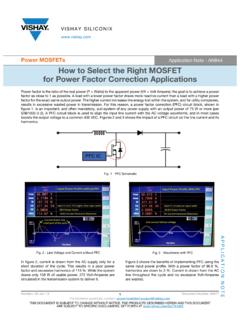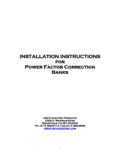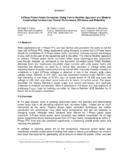Transcription of Power factor correction (PFC) application notes - eaton.com
1 Power factor correction (PFC) application notesOverview Every year, millions and millions of notebook computers, LCD monitors and LCD televisions are produced. With such a fast growing number of these and other electronic devices using more and more Power , actions must to be taken to ensure the functionality of the nationwide Power 2001, the European Union put EN61000-3-2 into effect to set the harmonic regulation standard on any Power grid supplied application with Power consumption over 75 watts. This essentially requires Power factor correction (PFC). Additionally, a standby Power dissipation limit is set to conserve Power when a load is OFF.
2 80 PLUS is an initiative funded by electric utilities to integrate more energy efficient Power Supply Units (PSUs) - especially for desktop computers and servers. 80 PLUS certifies to more than 80% energy efficiency at 20%, 50% and 100% of rated load. To meet the 80 PLUS certification, PSUs require a PFC of or greater at 100%load. This means PSUs that waste 20% or less electric energy (as heat at the specified load levels) will lead to reduced electricity consumption and lower bills. Rebates are sometimes given to manufacturers who use 80 PLUS certified Power factor correction (PFC) into switch mode Power supplies will maximize: Power handling capability of the Power supply Current handling capacities of Power distribution networksTechnical Note 4040 Effective December 2017 Supersedes 2010 Power factor correction (PFC) application notesInput Power factor (PF) is defined as:PF = Real Power (watts)Apparent Power (VA)PF is expressed as decimal number between zero and one (0 and 1).
3 A non-corrected Power supply with a typical PF equal to will draw approximately times greater input current than a PFC supply (PF = ) for the same output loading. The non-corrected supply requires additional AC current to be generated which is not consumed by the load, creating I2R losses in the Power distribution are two types of PFCs: Active Passive2 eaton factor correction (PFC) application notesTechnical Note 4040 Effective December 2017 Passive PFCThe simplest form of PFC is passive (Passive PFC). A passive PFC uses a filter at the AC input to correct poor Power factor . The passive PFC circuitry uses only passive components an inductor and some capacitors (Figure.)
4 1).Although pleasantly simple and robust, a passive PFC rarely achieves low Total Harmonic Distortion (THD). Also, because the circuit operates at the low line Power frequency of 50 Hz or 60 Hz, the passive elements are normally bulky and 1. A passive PFC circuit requires only a few components to increase efficiency, but they are large due to operating at the line Power frequencyBoost inductorThe boost-circuit based PFC topology is the most popular. It is an economical solution for complying with regulations (Figure 3). The inductance value is selected based on the desired current ripple in the boost inductor.
5 The inductance value is expressed as follows:AC+-PFC InductorDC BusActive PFCA ctive PFC offers better THD and is significantly smaller and lighter than a passive PFC circuit (Figure 2). To reduce the size and cost of passive filter elements, an active PFC operates at a higher switching frequency than the 50 Hz/60 Hz line frequency. Active PFC functions include: Active wave shaping of the input current Filtering of the high frequency switching Feedback sensing of the source current for waveformcontrol Feedback control to regulate output voltageBuck, boost, flyback and other converter topologies are used in active PFC DC-DC converter input capacitor also benefits from active PFC.
6 The capacitor can be sized to filter the high frequency ripple of the active PFC circuit instead of a much larger capacitor that would be required to smooth the 50-60 Hz input. The regulated input of the DC-DC converter also demands a lower range of duty cycle from the DC-DC converter. Other benefits of active PFC include increased hold-over-time. Hold over (brownout protection) benefits from always starting at the maximum voltage; and because energy in the capacitor is related to 1/2CV2, the capacitor can be much smaller than a capacitor in a converter without active CPFCI nductor+DCBus-Figure 2. An active PFC circuit produces low THD and uses relatively small passive = VpKin (min) * d(max)fs * iwhere: VpKin(min) is the peak minimum input voltage fs is the switching frequency i is the ripple current d(max) is the maximum duty cycle expressed as:d(max) = 1- VpKin(min)Vowhere Vois the output voltageThe rms boost inductor current is expressed as:IL (rms) = Iin(pk)A2 Inductor selectionEaton's PFC inductors are available for use with a wide variety of PFCs from 100 W to 250 W.
7 They operate with controllers from several IC manufacturers to provide PFC supply solutions that utilize either passive or active PFC applications (Table 1). eaton 's PFC inductors range from 200 H to mH. The standard input voltage range is 85 V to 385 V with different core materials such as ferrite, iron powder and Kool-Mu to provide significant low core loss. The E-core and toroidal geometries allow using thicker wire to decrease DC resist-ance and yield higher current capacity. Many vertical or horizontal through-hole mounting options are available with an operating temperature range of 20 C to +105 C (Table 2).
8 PFCB oostL ineM CC1L1C2C3F2F3 Cout++DC/DCConverteroutoutFigure 3. PFC Boost - Typical application circuit, & 5 V, 60 W combined output eaton Boulevard Cleveland, OH 44122 United 2017 EatonAll Rights Reserved Printed in USAP ublication No. 4040 December 2017 eaton is a registered other trademarks are property of their respective Note 4040 Effective December 2017 Power factor correction (PFC) application notesFusesAC Input Line FuseProduct safety standards written by Underwriters Laboratories (UL) and the International Electrotechnical Commission (IEC) require fuses for primary AC Power protection and secondary protection against any catastrophic failure within the input filter capacitors, PFC boost module, output electrolytic capacitors (Cout) or the DC-DC converters.
9 The PFC boost module usually does not contain overcurrent protection; if a short-circuit is applied across its output terminals, there is no internal circuit opening device to safely interrupt the Power . Without fuse protection in the AC input line (see fuse F1 in Figure 3), the boost converter is not the DC-DC converter input lines is essential for protection against a catastrophic DC-DC converter failure (see fuses F2 and F3 in Figure 3). F1: RoHS compliant S501-2-R fast-acting 5 x 20 mm ceramictube fuse rated for 2 A @ 250 Vac F2 & F3: RoHS compliant PC-Tron fast-acting PCB through-hole fuse rated up to 250 Vac/450 Vdc.
10 (Product codes PCB,PCC, PCD, PCE, PCF, PCH and PCI.) (Figure 4)PFCPFI mpact onPFCE nvironmentCostTypeAppearance WeightValueWith inputvoltage,None switch orNone50~60%BadNoneWith inputvoltage,Passive switch orHeaviest 70~80%BetterNormalWithoutinput voltage NormalswitchActive90~ xed inputvoltage xed inputvoltageTable 1. Comparison of passive and active PFC versus no 4. eaton 's Bussmann Series S501-2-R and PC-Tron FusesPFC TypePart NumberInductanceAux WdgGeometryCore MaterialMountingSize (mm)Output PowerCTX01-157891mH @ x 24 x 36-PassiveCTX02-12236500 H @ x x H @ x x H @ IronVerticle43 x 22 x @ x 48 x @ x 24 x 36100 WActiveCTX16-17309200 H @ H @ IronHorizontal40 x 40 x H @ @ x 27 x 13100 WProtecting the DC-DC ConverterAlthough the primary input line fuse will eventually activate, DC fuses positioned right at the input to the DC-DC converters will limit the energy delivered by the hold-up capacitors (Cout)
















